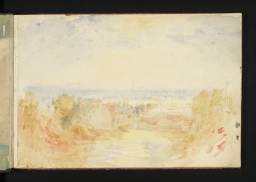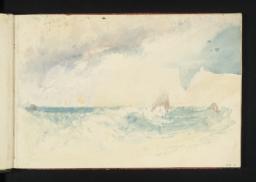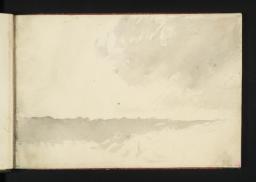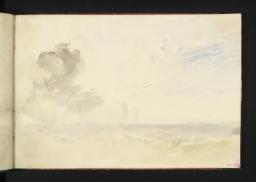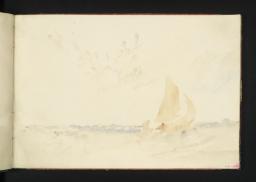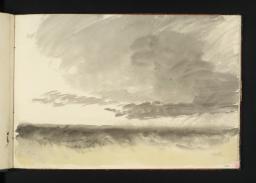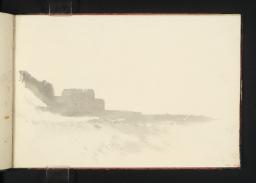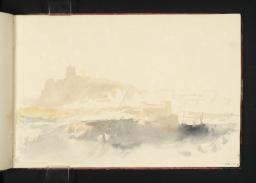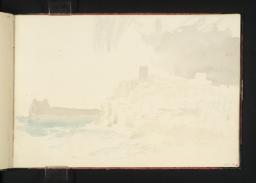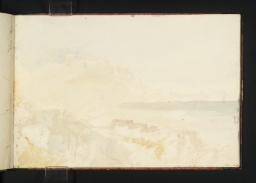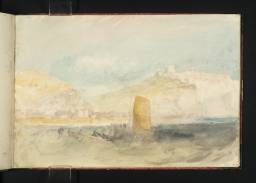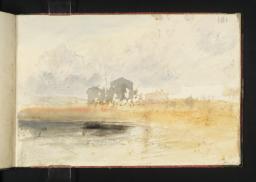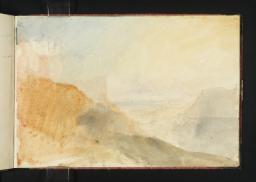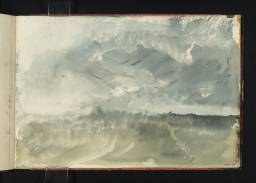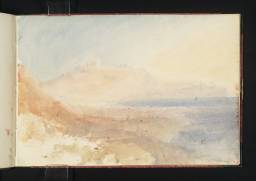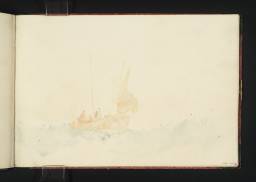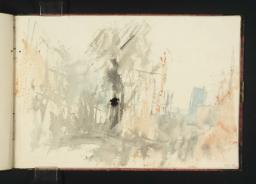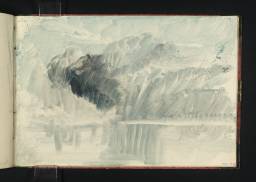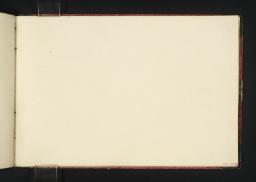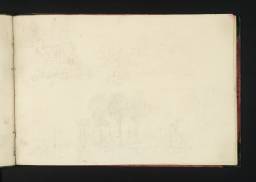Turner Bequest CCII 1–31a
Hardbound sketchbook half bound with dark green leather overlaps and red marbled paper; spine embossed at even intervals with thin gold horizontal bands
Bronze male/female clasp once attached for fastening, since broken with parts of it still embedded in the front and back covers
Some sheets watermarked ‘J whatman | 1815’
Inscribed by H.S. Trimmer in black ink ‘No 149’ and signed; by Charles Locke Eastlake ‘C.L.E.’, and by John Prescott Knight in pencil ‘JPK’, inside back cover, inverted, bottom right
Inscribed in pencil ‘7/66’ inside front cover, top left and inside back cover, inverted, bottom right
Inscribed in pencil ‘L 18’ inside front cover, top left
Inscribed in pencil CCII inside back cover, inverted, bottom right
Stamped in black ‘CCII’ inside front cover, top left
31 leaves of white wove paper with front and rear paste-downs of similar paper
Approximate page size 175 x 260 mm
Bronze male/female clasp once attached for fastening, since broken with parts of it still embedded in the front and back covers
Some sheets watermarked ‘J whatman | 1815’
Inscribed by H.S. Trimmer in black ink ‘No 149’ and signed; by Charles Locke Eastlake ‘C.L.E.’, and by John Prescott Knight in pencil ‘JPK’, inside back cover, inverted, bottom right
Inscribed in pencil ‘7/66’ inside front cover, top left and inside back cover, inverted, bottom right
Inscribed in pencil ‘L 18’ inside front cover, top left
Inscribed in pencil CCII inside back cover, inverted, bottom right
Stamped in black ‘CCII’ inside front cover, top left
31 leaves of white wove paper with front and rear paste-downs of similar paper
Approximate page size 175 x 260 mm
Accepted by the nation as part of the Turner Bequest 1856
Exhibition history
References
According to the Turner scholar Ian Warrell, this sketchbook appears to have been used by Turner ‘around 1822 in conjunction with a journey along the southern coast of England’.1 This tour is mentioned by Turner’s biographer Jack Lindsay who writes that the artist spent part of the summer of that year at the Kentish coastal towns of Folkestone, Hythe, and their environs.2 Warrell proposes that the majority of the twenty-two watercolour sketches depict the cliffs at Dover, as well as views of Portsmouth and Folkestone.3
The drawings in this sketchbook are in large part sky and seascapes: stretches of headland depicted on a tranquil morning or in the midst of a squall, framed by expansive skies and churning waters below (for example Tate D17722–D17723, D17726–D17728; Turner Bequest CCII 3, 4, 7–9). They are technically various, rendered with vigorous dry brush-strokes, broad applications of translucent wash, and daubs and streaks of added pigment which instantly diffuse to create evocative chromatic gradations. The drawings are similar in handling to the watercolour studies in the Skies sketchbook of about 1816–8 (Tate D12450–D12526; Turner Bequest CLVIII 2–69).4
A number of the folios in this sketchbook are thought to be preparatory material for views in the Ports of England watercolour and mezzotint engraving series (Tate D18142, D18143, D18150, D18152–D18154; Turner Bequest CCVIII I, J, Q, S, T, U). Turner was engaged by the engraver and publisher Thomas Goff Lupton between 1825 and 1828 to produce a series of marine views intended as a sequel to W.B. Cooke’s Rivers of England series (1822–6). Two of the colour sketches of Dover found in this sketchbook, for example, can be related to the finished Ports design of that harbour (Tate D17733, D17737; Turner Bequest CCII 14, 18).
This sketchbook’s view of Portsmouth, though it cannot be connected to a completed view or series, is particularly striking for its evocation of Claudian harbour scenes (Tate D17725; Turner Bequest CCII 6). Also of note are the sketches on folios twenty-two and twenty-three (Tate D17741–D17742; Turner Bequest CCII 22–3) where Turner’s bravura brushwork, vigour of handling, and experimental approach to the application of watercolour wash mark these drawings out as almost abstract in the rendering of form and atmosphere. In all, these rough watercolour sketches and studies, the Turner scholar Eric Shanes writes, perform ‘a crucial role’ in pictorial experimentation and ‘crystalisation’, in particular ‘where colour and tonal dynamics were concerned’.5
Turner’s watercolour depictions of maritime subject matter cease towards the end of the sketchbook. After folio twenty-five a curious series of classical compositions occur, all drawn in pencil on a section of the sheet with the sketchbook turned upside down relative to the foliation (Tate D17745, D17747, D17749, D17751, D17753, D17755, D17757; Turner Bequest CCII 25a, 26a, 27a, 28a, 29a, 30a, 31a). With the exception of a few interior scenes, these drawings largely depict embarkation scenes or city views featuring antique architecture such as porticoes and triumphal arches. These rough sketches do not appear to relate to finished designs of classical motifs or narratives; they are likely quickly wrought notations of corresponding compositional ideas.
How to cite
Alice Rylance-Watson, ‘Ports of England Sketchbook c.1822–4’, sketchbook, March 2013, in David Blayney Brown (ed.), J.M.W. Turner: Sketchbooks, Drawings and Watercolours, Tate Research Publication, September 2014, https://www

